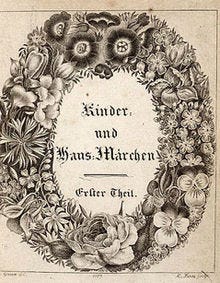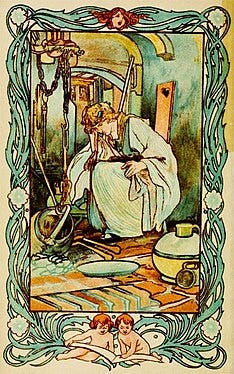The Short Fairy-Tale
We hear that things happened; we don't hear why.
When I was a kid, I happily poured through my dad's copy of Grimm's Fairy Tales. I can't remember which edition it was - there're a number online with various lists of stories - but it had dozens of stories in one normal-sized volume. My imagination was filled with so many stories of active adventure.
Of course, that meant each individual story was very short. There wasn't any other way to fit them all in one volume. But the original stories - told by peasants throughout Europe, and collected by the Brothers Grimm from nineteenth-century Germany - were also that short. We hear that things happened; we don't hear why. We don't hear the aftermath of events, outside the role they play in the main arc of the story.
I did like reading fairy tales. But they feel very different from reading more normal - more modern, perhaps - stories. They read like outlines, or the skeletons of stories.
For example, take “Cinderella”: in the folktale versions of the story, she gets her ballgown from a tree near her house which is somehow related to the spirit of her dead mother. (The Disney version substituted a fairy godmother.) We know what that gown did - it enabled her to go to the ball and meet the prince. We don't hear how she felt about her dead mother's spirit being in a tree, we don't hear why she asked her for that gown, and we don't hear what became of that tree after Cinderella married the prince and moved into the palace!
I recently read a book analyzing the literary structure of fairy tales - The European Folktale, published 1947 by Max Lüthi (translated from the Germany by John D. Niles) - which digs into this. This sparseness is a common thread across Europe in real folktales, Lüthi says, even though many redactors (including, famously, Perrault) added additional details and motivations and reactions. This sparseness, Lüthi concludes, serves an important purpose in the human psyche. I agree with this much - it must have served some purpose, since it's so pervasive. Lüthi suggests it helps people relate to events around them in the world where they don't see such connections.
I said fairy tales feel like the skeletons of stories. And, they can be the skeletons of stories. I've read myriads of fairy-tale retellings, which expand them with myriads of different characterizations. Let's take “Cinderella”, again. It's been retold as Ella Enchanted by Gail Carson Levine, Cinder by Marissa Meyer, The Stepsister Scheme by Jim C. Hines, Just Ella by Margaret Peterson Haddix - and those're just several that I can think of off the top of my head. All of these retellings have very different characterizations for Cinderella and the Prince, very different developments of magic, very different worldbuilding around the kingdom, and very different tones for the overall story. But, all of them are built around the events of the original “Cinderella”.
They often expand the story. In Levine's Ella Enchanted, for example, the events from the original fairy-tale take up four chapters out of the book’s thirty. Hines' Stepsister Scheme and Haddix's Just Ella start after the end of the fairy-tale to tell of the aftermath and loop back to the original events in retrospect. But when that happens, it's because of all the loose threads in the initial story. To answer those questions (say, what Cinderella felt about her mother, and what became of the tree) require enlarging the scope of the tale.
Why are the original fairy-tales, or (to use Lüthi’s term) folktales, so short and sparse?
My first thought is, perhaps because they were usually told aloud. It takes a lot longer to read a story aloud than read it to yourself, and your audience will probably be getting antsy before you finish something of any length. (Consider how long audiobooks take.) So when you're telling a tale aloud, it'll usually end up shorter than when you're writing it. If people want to hear more than one story in a night, each story will need to be even shorter.
This explains the length, but not necessarily the sparseness of reactions and motivations.
One question there is, were folktales actually so sparse? Did storytellers actually omit those details while telling them aloud, or is that just an artifact of how they were told to folklorists? Lüthi blames Charles Perrault, who recorded French folktales in the late 1600's, for adding various details - but did he actually add them, or did they get told to him but not to the Grimms?
I'm reminded of Albert Lord's The Singer of Tales, another foundational work in the study of folktales (published 1960, after Lüthi), taken from the study of oral bards in the Balkans. Lord points out that the invention of tape-recorders made it possible for the first time to record the ballads as they were actually sung. Every previous study had to have the singer wait after every couple lines for the ethnologist to write them down. This badly affected the singing, but worse for some bards than for others - and some, he suggests, made good use of that waiting to improve the story. Perhaps, when Perrault or the Grimms recorded folktales, some tellers added or removed details while waiting for them to be written?
But I do think Lüthi's conclusions of sparseness, by and large, are correct. We can see somewhat similar sparseness in the Welsh Mabinogion, or even the historical books of the Biblical Old Testament. For example, almost everything we hear of King David's reactions and emotions comes from the Psalms, not from the historical narrative. We can see a lot of this comes from the length of the story.
My guess, though, is that one major contributor to the sparseness of reactions and motivations in folktales is the oral nature. When I'm writing a story, I can look back over what I've written and see what I need to follow up on (such as Cinderella's mother's tree). Or, I can look back and see where to insert a paragraph about why she's doing what she's doing.
When I'm telling it aloud, I can't do that. I'm carried along by the plot. Maybe I'll remember in the middle of the wedding to talk about the tree (which I last mentioned ten minutes ago), but more likely not. Or, if I pause to tell of Cinderella's motivations, I'll need to keep track of those and refer consistently back to them throughout the story. Perhaps some tellers of tales will do this - but it's an extra burden. I'm not surprised it's rare.
Writing stories down makes them better. As well as (of course) making them more accessible, it's made it easier to make them more complicated and detailed. Perhaps that's less like real life as it sometimes appears to isolated villagers (as Lüthi says), but it's more like life as it actually is.
So, when I look back over Grimm's Fairy Tales, I can see it as relics from another age - not just in the sense that they were old tales, but that they're framed by their oral nature. Retellings of fairy tales are, truly, updating them for this new era.





Another factor to consider is the psychologizing of stories that occurred in the nineteenth century, which was part of the psychologizing of the understanding of human nature starting with Freud. Not that writers were unconcerned with motivations and feelings before Freud. Those concerns go all the way back in literature, to Achilles sulking in his tent and Hamlet agonizing over his revenge for his father. But until the nineteenth century, the moral understanding of human nature was still dominant and the simple moral tale, concerned with doing the right thing, rather than explaining why people do the wrong thing, was still in favor. Most fairy tales are essentially moral fables, and like moral fables going all the way back to Aesop, they had no need to explore motives or feelings.
You don't just tell a story once, though. You tell it again and again. And not just to people, but over in your head. Maybe it gets shorter, or maybe it gets longer - but you do have that automatic reviewing to notice things you forgot. And don't underestimate the ability of small children to come up with the "...but what happened to her mother in the tree?" questions.
(Answer: "She was happy that her child was finally safe and happy, and was able to be at peace," probably - I suspect that one isn't asked because it doesn't need to be. Fairy tales do have a sort of assumed background, which does a lot to fill in the things they leave out - I often suspect that part of why they seem sparse to us is that not all of that common background of knowledge and assumptions got passed down to us, so things that were obvious to the original audience don't remain so to the modern one.)
Have you run into the debate about the icelandic sagas? They're extremely long, with pretty clear character motivation; most of the family sagas occur multiple centuries before they were written down, and there's a debate about whether they were (per tradition) composed close to the events and preserved orally until written, or composed at the time of writing (and some details seem odd if the latter - there's one case where a detail in a saga matches up to a medical condition we now know about in a way we wouldn't expect them to have known, though that only requires that detail survives from close to the events, not the whole account) - though Iceland has very long winters.
At any rate, I'm less convinced that fairy tales are short because they can't fit in what a novel can, and the modern novel would be better. They're a different genre, and in some ways I think they can be stronger than a novel precisely because of the empty spaces. Sometimes things work better with less explanation.
But I enjoyed the essay.
(And I enjoyed Ella Enchanted - but it's a different kind of thing. In some ways it works precisely because it is constantly in tension with its source material - as do the large number of Tam Lins, one of which you reviewed in a different post. The fairytale framework lets the author tell the story with a preexisting knowledge of many plot elements that wouldn't usually be possible, and therefore use that preexisting knowledge to shape tension or curiosity, rather as stories built around prophecies or starting in medias res and then flashing back can - you know this one thing about what will happen, but what fits in around it?)